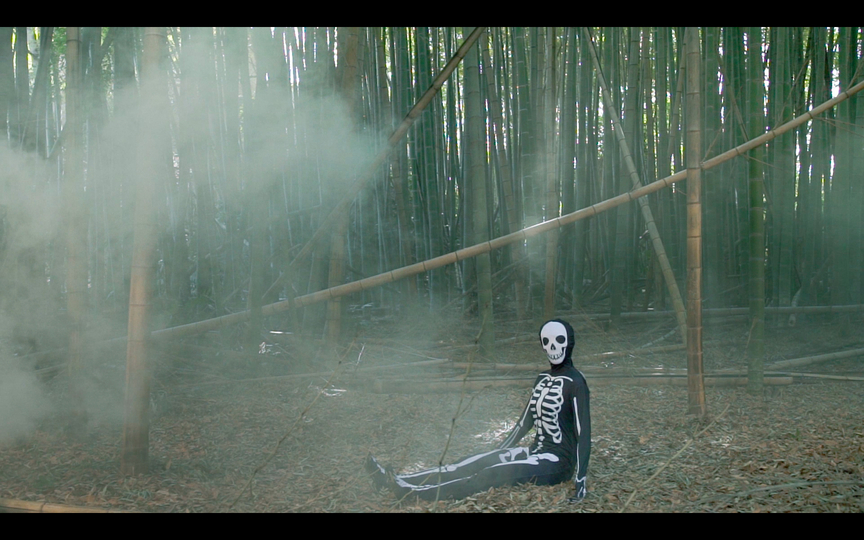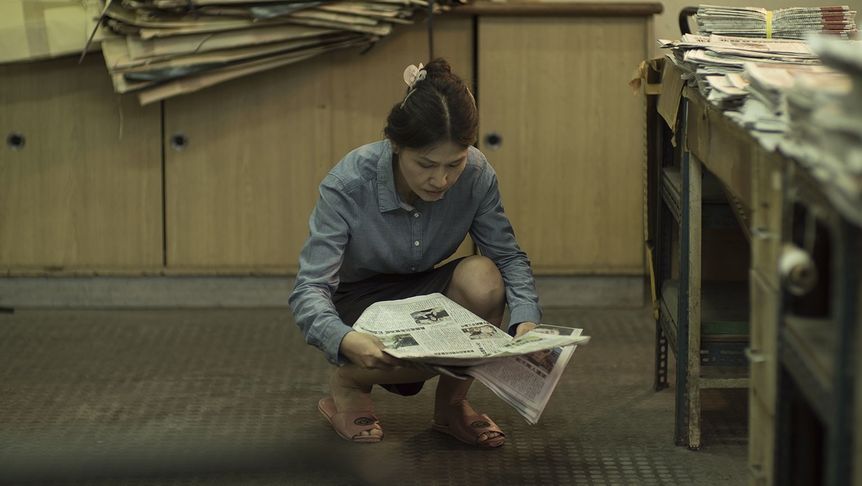
R
E
V N
E
X
T
Still image from ANTON VIDOKLE’s Citizens of the Cosmos, 2019, HD video in Japanese with English subtitles, color, sound: 30 min. Courtesy the artist.
The film program “Squere,” at this year’s Images Festival in Toronto, marked the Canadian premieres of Anton Vidokle’s Citizens of the Cosmos (2019) and Karolina Breguła’s Squere (2017). Screened together, the two films formed an enjoyable and thought-provoking dialogue centered on linkages between Eastern Europe and East Asia, revealing the push and pull between present and past (or future) in their respective sociopolitical spheres.
Citizens of the Cosmos is closely connected to Vidokle’s previous work, Immortality for All: A Film Trilogy on Russian Cosmism (2014–17), and is inspired by Soviet Cosmist thinker and poet Aleksandr Svyatogor’s manifesto, “Our Affirmations,” published in 1922 in Biocosmist magazine. The philosophical movement was oriented around resurrection, immortality on Earth, and fantasies of interplanetary exploration. Largely banned in the USSR during Stalin’s rule, Cosmism was introduced to Japan in 1943—one of the first instances of its translation beyond Soviet Russia. It is this intellectual transposition—and reimaginings of its contemporary manifestations—that Citizens aims to capture.
Filmed in Kiev and Tokyo, the film quite physically connects Eastern and Western philosophical traditions of Cosmism. The fantastical quality of the film is channeled through elaborate choreographed movements, sound, and interactions between humans and their surroundings (or objects). Some of the key tenets of Cosmism, notably its approach to death and reconnecting with deceased ancestors, are luminously and even playfully performed, as in a scene in which a few people listen to tombstones in a cemetery with stethoscopes. One of the particularly memorable final scenes depicts a Japanese funereal bone-picking ceremony taking place inside the Soviet-era Kiev Crematorium. The eerie, slightly orchestrated actions of the group of bone-pickers embody deeply human sensibilities that undergird traditions and ideals, which resonate beyond borders and cultures. Although the film is steeped in the aura of Russian Cosmism, its sensitive exploration of the movement’s wider impact opens up space for imagination, interpretation and reinterpretation.
Following Vidokle’s clean-cut, minimalistic and conceptually abstract film, Breguła’s feature-length Squere proceeds more conventionally between dramatization and documentary-making in a relatable way, as if the story could happen in any small neighborhood. Primarily set in Taiwan, the story surrounds a singing sculpture hidden inside a bush in the middle of a courtyard in a village. The sculpture attracts passersby and nearby residents by broadcasting “I would like to ask you a question” in a singsongy manner that starts out sounding mellow and gentle, but not much later becomes increasingly anxious and hysterical. In so doing, it instigates a spectrum of sentiments and states from curiosity, admiration, to grouped resentment. The first half of Squere is visually and acoustically delightful at the hand of moderate theatricality and plot development. In contrast, the second half of the film is energetically chaotic, buoyed by a strong emotional upsurge of fear, anger and helplessness.
Breguła inserts herself into the flow of the Taiwan-based episodes with multiple scenes filmed in Warsaw, with the two interspersed narrative strands structured as a call and response. In the Polish segments, Breguła can be seen dressed as a princess, running through a multicultural market after hearing about the discovery of the same singing sculpture outside, though she never manages to encounter it. The sculpture thus appears to symbolize intrusion in one segment, and loss in the other. The film witnesses the formation of societal anxieties projected through the villagers’ collective responses to the sculpture, and seems to hint at the sociopolitical turbulences that Taiwan may be facing in the current times; the Poland scenes subtly echo such traces of political and cultural fluctuation.
The two films in the program are both absurd and engaging in their own ways: Citizens conveys ideas with a great deal of precision, while Squere drags the viewer through a rollercoaster of emotions. They are also conceptual opposites: Vidokle’s film is centered on revisiting and reviving through the lens of Russian Cosmism and his own comprehension of it, whereas Breguła’s more ambivalent work both lingers on and distances the viewer from the mysterious sculpture, which evokes something bygone, unshakable, and unsettling. What unites them is how both films achieve an emotional resonance by drawing on fundamentally human sensibilities, irrespective of the settings’ unique societal contexts.
To read more of ArtAsiaPacific’s articles, visit our Digital Library.

















